In light of our recent video on the HK P9 (and comparison to the Czech vz.52 pistol), I though it would be interesting to take a look at an interesting prototype machine pistol. This was commissioned by a man named Henk Visser during the 1980s (when machine pistols had a brief flare of popularity) although it never went into production.
Mr. Visser was a man with a fascinating history – the first machine gun he owned was an MP-40 he stole from a German barracks in Holland when he was 18. He was caught, and spent 3 month on death row in a Nazi prison before family connections were able to get his sentence commuted to 15 years imprisonment. He wound up spending the better part of two years in a forced labor camp before returning to Holland nearly dead of tuberculosis. He wrangled his way into the arms business after the war, buying a mothballed .60 ammunition factory out of the US for a whopping $1000 and using it to produce 20mm ammunition for NATO. He had a long and well-connected career, including close associations with the CETME/HK G3 program, the AR-10, and eventually part ownership in Mauser. He used his significant accumulated wealth the amass a fantastic collection of arms, from medieval armor to the most modern firearms (including things like muzzle-loading cannons he had recovered from sunken Dutch warships). Sadly, Mr. Visser passed away several years ago – but I am digressing.
When you combine in one person the love of firearms, financial resources, and technical resources that Henk Visser had, you get a person who can decide to commission some prototype machine pistols if he wants to. That’s what this particular gun is; an experiment to see if the machine pistol market was something worth pursuing (these being made during the days of guns like the Beretta 93R, HK VP-70, Stechkin APS, and others). It started out life as a Czech vz.52 pistol:
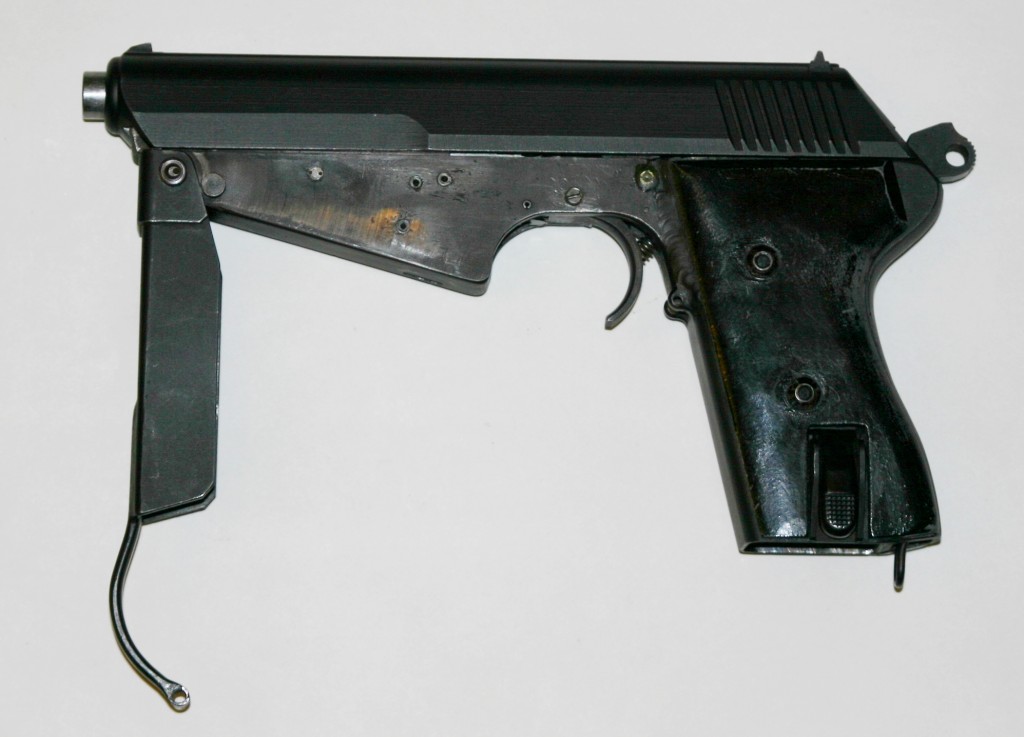
The vz.52 slide is pretty obvious, and the gun retains the 52’s roller-locked operating system. However, its frame has been significantly modified. Chambered for 9mm Luger ammunition, it uses a double-stack magazine very similar to (possibly interchangeable with) that of the Browning High Power, with an Uzi-like magazine catch on the side of the pistol grip. The fold-down front grip allows the gun to fire in full-auto mode, and gives the shooter a bit more control over the piece.
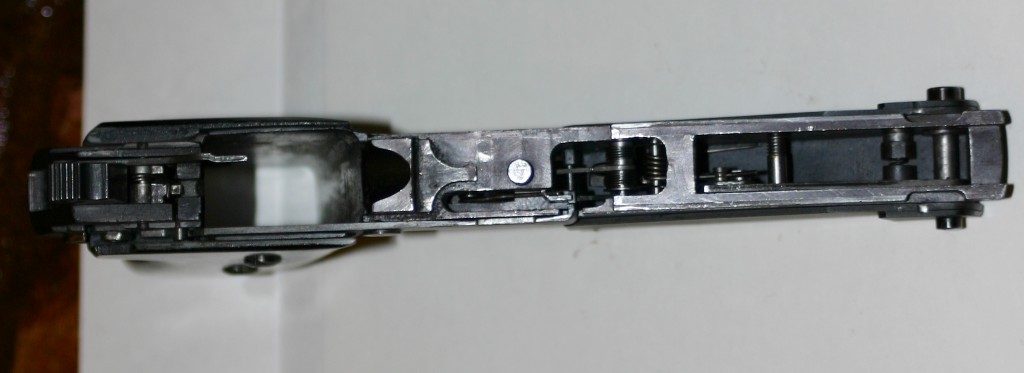
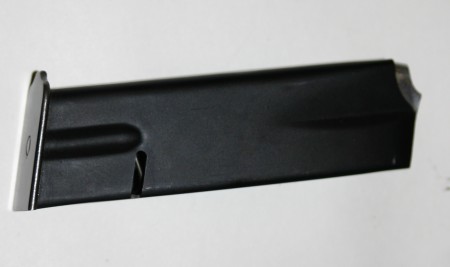
Unfortunately, I have no information on the development of this gun, whether it was ever put through formal tests or progressed any farther than this first prototype. I suspect it was replaced with a different machine pistol design, but I’m still tracking down information on that…
You can see the other photos of the gun here:

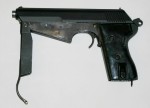
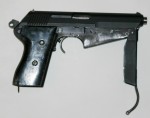








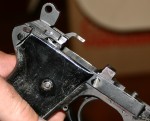



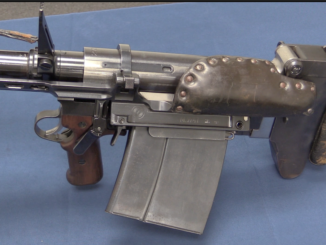

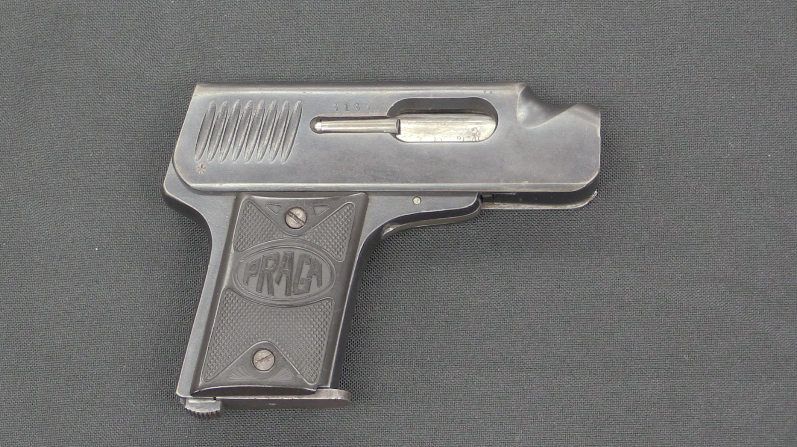
It’s a lot better looking than most machine pistols, and seems a lot harder to shoot your support hand off with
Excellent article on a (totally…) forgotten weapon. Thanks for posting this, Ian. It really makes you want to know more on this obscure prototype (and the rationale behind such endeavour).
Mr Visser is truly missed by many, including myself, who were on the receiving end of his generosity. He had a wonderful collection, most of which was willed to the Dutch Army Museum in Delft, which held a wonderful exhibit of his early Dutch firearms. He also funded a thorough research of Dutch firearms and made gifts of beautifully-printed several hundred to over thousand pages full color printed catalogs resplendent with the photos of these – like they were visiting cards, or ad flyers. I had an opportunity to meet him when he visited Warsaw accompanied by Tom Nelson, and donated a rare Polish-emigree designed SMG to the Warsaw’s Polish Army Museum. We had like two hours of talk and ever since then I was privileged to get X-Mas cards and following volumes of that Dutch Firearms series (there were 8 or 9 of them in total). As I’m rather into more modern stuff, these ended up in the Polish Army’s Museum’s library. I really miss the letters and meetings we had.
Sorry for an off-topic and overtly personal post, hope nobody minds it.
How dare you tell a charming personal story about a very interesting man 😉
Thank you for sharing!
Not at all, very interesting, i will visit the museum in Delft one of these days…. Kind regards, Hans Ritzema, the Netherlands.
Legermuseum is currently moving to a new location and closed since end of last year. Reopening will be in 2014.
Nah, it’s cool. Anyway, how hard would it be to take a look at those catalogs? Which Polish Army Museum are they in and is the library open to the public?
Leszek, we all have certain soft spots for people and events that have helped shape our lives and outlooks in one way or the other. It is a part of the human condition, even when we sometimes become impatient with others. In that light, please do not apologize — I think we all understand, perhaps better than one might think.
Respect for, and adherence to, objective hard facts is of utmost importance, but so is humanity and the ability to give and take.
I had the oportunity to spend time at Henk house and got to look and play with his collection. There is a patent for this pistol in his name. He was a true gentlemen and is missed.
This looks like it might be the patent – with burst fire
http://worldwide.espacenet.com/publicationDetails/originalDocument?CC=US&NR=3803976A&KC=A&FT=D&ND=3&date=19740416&DB=EPODOC&locale=en_EP
Gosh ! I have a VZ-52 almost unissued in regular semi-auto at home, but I did not expect to see this ! However, I guess holding the recoil of full auto must be a match thinking of the recoil I get by the single shot…!!
Keep up ! Greetings from Venice, Italy
As much as I look I cannot see anything resembling usual roller set or any other locking/ recoil delay device.
That’s because the rollers are in the slide, which I unfortunately do not have a photo of.
Great post! Keep up the awesome work.
The frame looks to be completely custom-made from welded sheet steel. A very interesting design overall.
I was loooking at that and wondering whether it incorporated bits of the original receiver, like slide ways and the lockwork, welded into the new sheet and box section fabrication.
The mag looks like it has been opened up to give dual feed position too. Its feed lips certainly don’t look as narrow as I remember original GP35 mags
For what its worth, it appears that this machine pistol’s receiver is a stamped steel exoskeleton constructed around the front and rear parts of an original vz.52 receiver. The machining cuts in the top view are identical to those in a vz.52 and it appears that much of the original pistol’s lockwork was used as well.
Yes, it is quite visible. You are better observer than me. This way thanks to Editor as well for posting it.
Overall, fair attempt, although as prototype looks still bit rough. If Czechs picked up on it, they may have had better weapon than vz.63 Skorpion.
Depending on where receivers get cut for scrapped pistols to legally get into the US, there could be some very interesting build projects for Americans.
My memory doesn’t do names, so I’ve forgotten who the custom pistol smith was who found a barrel full of cut up 1911 slides, and had the idea of welding some to make short slide carry guns and using the leftover bits to make long slide target guns.
addendum: very interesting semi auto build projects.
Would that be Pat Yates and the Detonics Combat Master? Here is an article written by the man himself explaining the origins of his gun: http://www.biggerhammer.net/detonics/detonics_history_patyates.html
wow! thanks Big Al,
Detonics wasn’t who I was trying to think of, but that link is really interesting, and was well worth the frustration of my not being able to remember.
That article certainly answers a lot of questions I had about my memories of Detonics guns – ammongst those questions was why the cut down back of the slide and the reduced sight base?
I remember reading a review of a tiny detonics chambered for their proprietary .451 mag a slightly lengthened case to prevent it chambering in ordinary .45ACP guns, and with a much thicker web in the head, to correct the pressure limitation inherrent in 1911 pistols with conventional 45ACP Ammo. The relief of the chamber at the feed ramp allows the thin brass of the case wall to be exposed, and increasing pressure over the c20K psi max (half the operating pressure of 9mm P ) will bulge or even pop the case…
I bet it was a little bundle of joy to practice with.
Here’s a patent for the Detonics recoil spring and buffer assembly
http://worldwide.espacenet.com/publicationDetails/originalDocument?CC=US&NR=4522107A&KC=A&FT=D&ND=3&date=19850611&DB=EPODOC&locale=en_EP
OK, the name of the person who welded up long slides has come to me, it was James Clark senior
excerpted from beside the lowest prtrait, right at the bottom of the page here: http://www.bullseyepistol.com/clark.htm
Looks like a proto type of the Visser assault pistol 75/77 ref in Worlds Machine pistols and submachine guns by Nelson ,Musgrave.
Mr Visser also developed the grenade body for the “Baseball” hand grenade that was adopted by the U.S. army and used in Vietnam. I heard he received a $.05 each for all we made and we made a lot of them. Henk ended up with Serial # 4 9mm Mauser model 12-14 that I had. It was a flapper locked Mauser pocket model enlarged allot to 9 mm Parabellum size. A few were made in 45 ACP also. Mine was weird as it had a strait winged Nazi proof on it but the gun was made way before they came to power. Mr Visser was a true gentleman and shared his knowledge freely. He is missed.
Just wanted to chime in with some more info. To confirm what Keith said earlier, that patent does apply to Mr. Visser’s prototype. The patent number was stamped along the slide of the later pistols. The patent describes the mechanism by which the forend controlled the sear, switching the trigger to 3rd burst when folded down. Like KJohns pointed out, the “final” form is described in some detail in Volume 2 of Nelson and Musgrave’s subgun reference guide. Some great pictures of both versions, the Vasp 75 and Vasp 77 are included. The description given in the book says that the prototype had a frame based on a BHP. Could be where the BHP magazine came from? Probably the best line in the description says that the gun is still undergoing government testing. Should anyone want to read more, the photos and description are on pages 270-274, and 654, of the First Edition, Volume 2. ISBN 0-686-15933-0. I would scan the pages, but I can’t risk my copy. It came from the library of the late Don Stoehr, and has not weathered the years well.
Good information — thank you for your generosity in sharing this. It’s perfectly understandable that you don’t want to risk a fragile and precious document, but I was thinking that one possible way around the problem is to photograph said document and then transmit those images instead. Since I honestly don’t know the exact detailed circumstances surrounding your situation, please understand that this is only a helpful suggestion on my part.
I saw the collection of Henk Visser today in the army museum in soesterberg the Netherlands, I’didnt know that it was his collection, so I was really suprised that the dutch army had
such strange and rare weapons. like a M1 carbine with an infrared scope the stoner 63,
a garand and enfield no.4 with the orignal scope. and of course the most interesting
piece which i didnt know that it exists, the vz52 which look like full auto with
a double stack magazine. so I started a search on the internet and her we are.
If you want to see more photos of his collection or the museum
my mailadress is levspanjar@hmamail.com I am happy to make them for you
the adress of the museum in the Netherlands with his collection.
Verlengde Paltzerweg 1,
3768 MX Soest
the Netherlands
thanks for this awesome site and the videos booth on youtube and full30
Ones, years ago a saw a video demonstration of the VisserASsaultPistol being fired bij H. Visser himself and i am searching for that video ever since!
I have seen a video demonstration by Henk Visser himself of the VisserASsaulPistol many years ago so there is video in excistence but i am searching futile for years now.
This gun came up in some unrelated research. The “VASP” was designed for by Walter Ludwig formerly of the SIG. The design is covered under US Patent 3,803,976 (1974) and an earlier patent was issued in the Netherlands 7,111,952 (1971). Ludwig wrote the original draft of the patent description (in German). Ludwig described it as an “Automatpistole mit Schussbegrenzer” (automatic pistol with shot limiter). I have a faded copy of the original typed patent description. I also have a document entitled “Die Entwicklungsgeschichte der VASP” (the Development history of the VASP). I am working through it. How is your German?
After working through a bit more of the materials that came up in some other research it provided a few more tantalizing details that may be worthy of follow-up. It appears that in the 1970’s, Visser traveled to the U.S. with Ludwig to meet with Eugene Stoner and have Stoner review the blueprints. Stoner made some corrections to the design and then had some of the small parts of the pistol made in an American factory. The first pistol was then assembled by Paul Norton Van Hee, Jr. of Norton Armaments in Mt. Clements, MI. The first trials were undertaken by Hans Sturz at Norton. There were a series of malfunctions that they tried to work out but some could not be solved. Van Hee ended his tests and Stoner took up the testing.
The main problem with the VASP is that the standard 9×19 was a tad too powerful to be fired with some degree of accuracy in burst mode.
They did experiment with other calibers and I have a strong believe that he even ordered specially developed reduced charge 9×19 rounds from GeCo in Germany. I have some cartons as well as an original GeCo shipping box addressed to him over here.